Spatial Variation and Terrain Gradient Effect of Ecosystem Services in Heihe River Basin over the Past 20 Years
Abstract
:1. Introduction
2. Materials and Methods
2.1. Study Area
2.2. Data Sources
2.3. Methodology
2.3.1. Habitat Quality (HQ)
2.3.2. Water Yield (WY)
2.3.3. Soil Conservation (SC)
2.4. Terrain Niche Index
3. Results
3.1. Spatiotemporal Variations of ESs
3.1.1. Spatial Distribution and Variation of HQ
3.1.2. Spatial Distribution and Variation of WY
3.1.3. Spatial Distribution and Variation of SC
3.2. TGE of Different ESs
3.2.1. Terrain Niche Index of HRB
3.2.2. TGE of HQ
3.2.3. TGE of WY
3.2.4. TGE on SC
4. Discussion
4.1. Validation of Results with Previous Works
4.2. Driving Forces of ESs Variation
4.3. Suggestions for Sustainable Improvement of ESs
4.4. Limitations and Future Study
5. Conclusions
Author Contributions
Funding
Institutional Review Board Statement
Informed Consent Statement
Data Availability Statement
Acknowledgments
Conflicts of Interest
References
- Fu, B.; Zhou, G.; Bai, Y.; Song, C.; Liu, J.; Zhang, H.; Lü, Y.; Zheng, H.; Xie, G. The main terrestrial ecosystem services and ecological security in China. Adv. Earth Sci. 2009, 24, 571–576. [Google Scholar] [CrossRef]
- Chen, Y.-F.; Zhou, J.-X.; Xiao, J.; Li, Y.-P. Forecasting loss of ecosystem service value using a BP network: A case study of the impact of the South-to-north Water Transfer Project on the ecological environmental in Xiangfan, Hubei Province, China. Biomed. Environ. Sci. 2003, 16, 379–391. [Google Scholar] [CrossRef] [PubMed]
- Zhang, H.; Wang, Q.; Li, G.; Zhang, H.; Zhang, J. Losses of ecosystem service values in the Taihu Lake Basin from 1979 to 2010. Front. Earth Sci. 2017, 11, 310–320. [Google Scholar] [CrossRef]
- Wang, C.; Li, X.; Yu, H.; Wang, Y. Tracing the spatial variation and value change of ecosystem services in Yellow River Delta, China. Ecol. Indic. 2019, 96, 270–277. [Google Scholar] [CrossRef]
- Gao, Y.; Wang, W.; Liu, X.; Zhang, L.; Dend, F.; Yang, C.; Sun, Q. Evaluation of carbon sequestration of forest ecosystem in Xiamen City. Res. Environ. Sci. 2019, 32, 2001–2007. [Google Scholar] [CrossRef]
- Zhao, Q.; Wen, Z.; Chen, S.; Ding, S.; Zhang, M. Quantifying land use/land cover and landscape pattern changes and impacts on ecosystem services. Int. J. Environ. Res. Public Health 2019, 17, 126. [Google Scholar] [CrossRef] [PubMed] [Green Version]
- Zhang, X.; He, S.; Yang, Y. Evaluation of wetland ecosystem services value of the yellow river delta. Environ. Monit. Assess. 2021, 193, 353. [Google Scholar] [CrossRef] [PubMed]
- Ye, Y.; Zhang, J.; Wang, T.; Bai, H.; Wang, X.; Zhao, W. Changes in land-use and ecosystem service value in Guangdong Province, Southern China, from 1990 to 2018. Land 2021, 10, 426. [Google Scholar] [CrossRef]
- Xie, G.; Cao, S.; Lu, C.; Xiao, Y.; Zhang, Y. Human’s consumption of ecosystem services and ecological debt in China. J. Nat. Resour. 2010, 25, 43–51. [Google Scholar] [CrossRef]
- Ouyang, Z.; Wang, X.; Miao, H. Preliminary study on the service function and eco economic value of terrestrial ecosystem in China. Acta Ecol. Sin. 1999, 19, 19–25. [Google Scholar] [CrossRef]
- Zhao, J.; Xiao, H.; Wu, G. Comparison analysis on physical and value assessment methods for ecosystems services. Chin. J. Appl. Ecol. 2000, 11, 290–292. [Google Scholar] [CrossRef]
- Groot, R.D.; Brander, L.; Ploeg, S.V.D.; Costanza, R.; Bernard, F.; Braat, L.; Christie, M.; Crossman, N.; Ghermandi, A.; Hein, L.; et al. Global estimates of the value of ecosystems and their services in monetary units. Ecosyst. Serv. 2012, 1, 50–61. [Google Scholar] [CrossRef]
- Costanza, R.; Groot, R.D.; Sutton, P.; Ploeg, S.V.D.; Anderson, S.J.; Kubiszewski, I.; Farber, S.; Turner, R.K. Changes in the global value of ecosystem services. Glob. Environ. Chang. 2014, 26, 152–158. [Google Scholar] [CrossRef]
- Chen, Z.; Zhang, X. The value of ecosystem benefits in China. Chin. Sci. Bull. 2000, 45, 17–22. [Google Scholar] [CrossRef]
- Xie, G.; Zhang, C.; Zhang, L.; Chen, W.; Li, S. Improvement of the evaluation method for ecosystem service value based on per unit area. J. Nat. Resour. 2015, 30, 1243–1254. [Google Scholar] [CrossRef]
- Costanza, R.; d’Arge, R.; Groot, R.D.; Farber, S.; Grasso, M.; Hannon, B.; Limburg, K.; Naeem, S.; O’Neill, R.V.; Paruelo, J.; et al. The value of the world’s ecosystem services and natural capital. Nature 1997, 387, 253–260. [Google Scholar] [CrossRef]
- Xie, G.; Lu, C.; Leng, Y.; Zheng, D.; Li, S. Ecological assets valuation of the Tibetan Plateau. J. Nat. Resour. 2003, 18, 189–196. [Google Scholar] [CrossRef]
- Li, H.; Li, Z.; Li, Z.; Yu, J.; Liu, B. Evaluation of ecosystem services: A case study in the middle reach of the Heihe River Basin, Northwest China. Phys. Chem. Earth 2015, 89–90, 40–45. [Google Scholar] [CrossRef]
- Sutton, P.C.; Anderson, S.J.; Costanza, R.; Kubiszewski, I. The ecological economics of land degradation: Impacts on ecosystem service values. Ecol. Econ. 2016, 129, 182–192. [Google Scholar] [CrossRef]
- Jiang, W.; Fu, B.; Lü, Y. Assessing impacts of land use/land cover conversion on changes in ecosystem services value on the Loess Plateau, China. Sustainability 2020, 12, 7128. [Google Scholar] [CrossRef]
- Wang, Y.; Zhang, S.; Zhen, H.; Chang, X.; Shataer, R.; Li, Z. Spatiotemporal evolution characteristics in ecosystem service values based on land use/cover change in the Tarim River Basin, China. Sustainability 2020, 12, 7759. [Google Scholar] [CrossRef]
- Yin, N.; Wang, S.; Liu, Y. Ecosystem service value assessment: Research progress and prospects. Chin. J. Ecol. 2021, 40, 233–244. [Google Scholar] [CrossRef]
- Wu, C.; Ma, G.; Yang, W.; Zhou, Y.; Peng, F.; Wang, J.; Yu, F. Assessment of ecosystem service value and its differences in the Yellow River Basin and Yangtze River Basin. Sustainability 2021, 13, 3822. [Google Scholar] [CrossRef]
- Su, K.; Wei, D.-Z.; Lin, W.-X. Evaluation of ecosystem services value and its implications for policy making in China—A case study of Fujian province. Ecol. Indic. 2020, 108, 105752. [Google Scholar] [CrossRef]
- Ouyang, Z.; Zheng, H.; Xiao, Y.; Polasky, S.; Liu, J.; Xu, W.; Wang, Q.; Zhang, L.; Xiao, Y.; Rao, E.; et al. Improvements in ecosystem services from investments in natural capital. Science 2016, 352, 1455–1459. [Google Scholar] [CrossRef]
- Yuan, Z.; Wan, R. A review on the methods of ecosystem service assessment. Ecol. Sci. 2019, 38, 210–219. [Google Scholar] [CrossRef]
- Odum, H.-T.; Odum, E.-P. The energetic basis for valuation of ecosystem services. Ecosystems 2000, 3, 21–23. [Google Scholar] [CrossRef]
- Sherrouse, B.-C.; Clement, J.-M.; Semmens, D.-J. A GIS application for assessing, mapping, and quantifying the social values of ecosystem services. Appl. Geogr. 2011, 31, 748–760. [Google Scholar] [CrossRef]
- Sharps, K.; Masante, D.; Thomas, A.; Jackson, B.; Redhead, J.; May, L.; Prosser, H.; Cosby, B.; Emmett, B.; Jones, L. Comparing strengths and weaknesses of three ecosystem services modelling tools in a diverse UK river catchment. Sci. Total Environ. 2017, 584, 118–130. [Google Scholar] [CrossRef] [Green Version]
- Villa, F.; Bagstad, K.-J.; Voigt, B.; Johnson, G.-W.; Portela, R.; Honzak, M.; Batker, D. A methodology for adaptable and robust ecosystem services assessment. PLoS ONE 2014, 9, e91001. [Google Scholar] [CrossRef]
- Wang, X.; Liu, X.; Long, Y.; Liang, W.; Zhou, J.; Zhang, Y. Analysis of Soil retention service function in the North Area of Guangdong based on the InVEST model. In IOP Conference Series: Earth and Environmental Science, Proceedings of the Fourth International Workshop on Renewable Energy and Development, Sanya, China, 24–26 April 2020; IOP: Bristol, UK, 2020; Volume 510, p. 510. [Google Scholar] [CrossRef]
- Gao, J.; Zuo, L. Revealing ecosystem services relationships and their driving factors for five basins of Beijing. J. Geogr. Sci. 2021, 31, 111–129. [Google Scholar] [CrossRef]
- Hu, W.; Li, G.; Gao, Z.; Jia, G.; Wang, Z.; Li, Y. Assessment of the impact of the Poplar Ecological Retreat Project on water conservation in the Dongting Lake wetland region using the InVEST model. Sci. Total. Environ. 2020, 733, 139423. [Google Scholar] [CrossRef]
- Zhang, X.; Zhou, J.; Li, M. Analysis on spatial and temporal changes of regional habitat quality based on the spatial pattern reconstruction of land use. Acta Geogr. Sin. 2020, 75, 160–178. [Google Scholar] [CrossRef]
- Bai, Y.; Chen, Y.; Alatalod, J.; Yang, Z.; Jiang, B. Scale effects on the relationships between land characteristics and ecosystem services—A case study in Taihu Lake Basin, China. Sci. Total. Environ. 2020, 716, 137083. [Google Scholar] [CrossRef]
- Aneseyee, A.B.; Elias, E.; Soromessa, T.; Feyisa, G.L. Land use/land cover change effect on soil erosion and sediment delivery in the Winike watershed, Omo Gibe Basin, Ethiopia. Sci. Total. Environ. 2020, 728, 138776. [Google Scholar] [CrossRef] [PubMed]
- Geng, X.; Wang, X.; Yan, H.; Zhang, Q.; Jin, G. Land use/land cover change induced impacts on water supply service in the upper reach of Heihe River Basin. Sustainability 2014, 7, 366–383. [Google Scholar] [CrossRef] [Green Version]
- Wang, X.; Dai, E.; Zhu, J. Spatial patterns of forest ecosystem services and influencing factors in the Ganjiang River Basin. J. Resour. Ecol. 2016, 7, 439–452. [Google Scholar] [CrossRef]
- Fang, Z.; Bai, Y.; Jiang, B.; Alatalo, J.-M.; Liu, G.; Wang, H. Quantifying variations in ecosystem services in altitude-associated vegetation types in a tropical region of China. Sci. Total. Environ. 2020, 726, 138565. [Google Scholar] [CrossRef]
- Aneseyee, A.B.; Noszczyk, T.; Soromessa, T.; Elias, E. The InVEST habitat quality model associated with land use/cover changes: A qualitative case study of the Winike Watershed in the Omo-Gibe Basin, Southwest Ethiopia. Remote Sens. 2020, 12, 1103. [Google Scholar] [CrossRef] [Green Version]
- Zhang, J.; Ren, Z. Spatiotemporal pattern and terrain gradient effect of land use change in Qinling-Bashan mountains. Trans. Chin. Soc. Agric. Eng. 2016, 32, 250–257. [Google Scholar] [CrossRef]
- Gong, W.; Yuan, L.; Fan, W. Analysis on land use pattern changes in Harbin based on terrain gradient. Trans. Chin. Soc. Agric. Eng. 2013, 29, 250–259. [Google Scholar] [CrossRef]
- Chen, Y.; Li, J.; Xu, J. The impact of socio- economic factors on ecological service value in Hubei Province: A geographically weighted regression approach. Chin. Land Sci. 2015, 29, 89–96. [Google Scholar] [CrossRef]
- Zeng, J.; Li, J.; Yao, X. Spatio-temporal dynamics of ecosystem service value in Wuhan Urban Agglomeration. Chin. Appl. Ecol. 2014, 25, 883–891. [Google Scholar] [CrossRef]
- Wang, Q.; Li, Y.; Liu, Y.; Hu, X. Analysis of spatial pattern of land use based on terrain gradient in karst trough valley area. Acta Ecol. Sin. 2019, 39, 7866–7880. [Google Scholar] [CrossRef]
- Yang, B.; Wang, Z.; Yao, X.; Zhang, L. Terrain gradient effect and spatial structure characteristics of land use in mountain areas of northwestern Hubei province. Resour. Environ. Yangtze Basin 2019, 28, 313–321. [Google Scholar] [CrossRef]
- Ma, S.; Qiao, Y.; Wang, L.; Zhang, J. Terrain gradient variations in ecosystem services of different vegetation types in mountainous regions: Vegetation resource conservation and sustainable development. For. Ecol. Manag. 2021, 482, 118856. [Google Scholar] [CrossRef]
- Wang, L.; Ma, S.; Jiang, J.; Zhao, Y.; Zhang, J. Spatiotemporal variation in ecosystem services and their drivers among different landscape heterogeneity units and terrain gradients in the southern hill and mountain belt, China. Remote Sens. 2021, 13, 1375. [Google Scholar] [CrossRef]
- Liu, W. Scientific understanding of the Belt and Road Initiative of China and related research themes. Prog. Geogr. 2015, 34, 538–544. [Google Scholar] [CrossRef]
- Liu, H.; Yeerken, W.; Wang, C. Impacts of the Belt and Road Initiative on the spatial pattern of territory development in China. Prog. Geogr. 2015, 34, 545–553. [Google Scholar] [CrossRef]
- Wang, Y.; Li, B.; Liu, J.; Feng, Q.; Liu, W.; Wang, X.; He, Y. Effects of cascade reservoir systems on the longitudinal distribution of sediment characteristics: A case study of the Heihe River Basin. Environ. Sci. Pollut. Res. 2021, 28, 1–13. [Google Scholar] [CrossRef]
- Wang, B.; Zhao, J.; Hu, X. Spatial pattern analysis of ecosystem services based on InVEST in Heihe River Basin. Chin. J. Ecol. 2016, 35, 2783–2792. [Google Scholar] [CrossRef]
- Ning, B.; He, Y.; He, X.; Li, Z. Research progress of water resources in Heihe River Basin. J. Desert Res. 2008, 28, 1180–1185. [Google Scholar]
- Tallis, H. Natural Capital: Theory and Practice of Mapping Ecosystem Services; Oxford University Press: Oxford, UK, 2011. [Google Scholar]
- Lin, Y.-P.; Lin, W.-C.; Wang, Y.-C.; Wang, Y.-C.; Lien, W.-Y.; Huang, T.; Hsu, C.-C.; Schmeller, D.S.; Crossman, N.D. Systematically designating conservation areas for protecting habitat quality and multiple ecosystem services. Environ. Model Softw. 2017, 90, 126–146. [Google Scholar] [CrossRef]
- Bao, Y.; Liu, K.; Li, T.; Hu, S. Effects of land use change on habitat based on InVEST model-taking Yellow River Wetland nature reserve in Shaanxi Province as an example. Arid Zone Res. 2015, 32, 622–629. [Google Scholar] [CrossRef]
- Wang, Y.; Meng, J. Effects of land use change on ecosystem services in the middle reaches of the Heihe River Basin. Arid Zone Res. 2017, 34, 200–207. [Google Scholar] [CrossRef]
- Zhou, W.; Liu, G.; Pan, J.; Feng, X. Distribution of available soil water capacity in China. J. Geogr. Sci. 2005, 15, 3–12. [Google Scholar] [CrossRef]
- Zhao, Y. Evaluation of Watershed Ecosystem Service Function Based on Invest Model. Master’s Thesis, Lanzhou University, Lanzhou, China, 2017. [Google Scholar] [CrossRef]
- Gao, H.; Han, H.; Yu, H.; Han, M. Distribution characteristic of important ecosystem services in terrain gradient in Wujiang River Basin. Ecol. Sci. 2016, 35, 154–159. [Google Scholar] [CrossRef]
- Xu, C.; Gong, J.; Li, Y.; Yan, L.; Gao, B. Spatial distribution characteristics of typical ecosystem services based on terrain gradients of Bailongjiang Watershed in Gansu. Acta Ecol. Sin. 2020, 40, 4291–4301. [Google Scholar] [CrossRef]
- Jiang, S.; Meng, J.; Chen, Y. Analysis of hydrological effects of land use and landscape pattern in the middle reaches of Heihe River. Sci. Soil Water Conser. 2019, 17, 64–73. [Google Scholar] [CrossRef]
- Li, Q.; Wang, L.; Yan, C.; Liu, H. Simulation of urban spatial expansion in oasis towns based on habitat quality: A case study of the middle reaches of Heihe River. Acta Ecol. Sin. 2020, 40, 2920–2931. [Google Scholar] [CrossRef]
- Dun, Y.; Yang, C.; Yuan, X.; Yang, Y.; Xiao, F.; Liang, S.; Lu, X. Researches on watershed ecosystem services. Ecol. Econ. 2019, 35, 179–183. [Google Scholar]
- Wang, P.; Li, Z.; Gao, W.; Yan, D.; Bai, J.; Li, K.; Wang, L. Glacier changes in the Heihe River Basin over the past 50 years in the context of climate change. Res. Sci. 2011, 33, 399–407. Available online: http://ir.casnw.net/handle/362004/8103 (accessed on 17 June 2021).
- Wang, L.; Zhang, X. Effect of the recent climate change on water resource in Heihe River Basin. J. Arid Land Res. Environ. 2010, 24, 60–65. [Google Scholar] [CrossRef]
- Zhang, K.; Wan, R.; Han, H.; Wang, X.; Si, J. Hydrological and water resources effects under climate change in Heihe River Basin. Res. Sci. 2007, 29, 77–83. [Google Scholar] [CrossRef]
- Tian, F.; Lü, Y.; Fu, B.; Yang, Y.; Qiu, G.; Zang, C.; Zhang, L. Effects of ecological engineering on water balance under two different vegetation scenarios in the Qilian Mountain, northwestern China. J. Hydrol. 2016, 5, 324–335. [Google Scholar] [CrossRef] [Green Version]
- Cheng, G.; Li, X.; Zhao, W.; Xu, Z.; Xiao, H. Integrated study of the water–ecosystem–economy in the Heihe River Basin. Natl. Sci. Rev. 2014, 1, 413–428. [Google Scholar] [CrossRef] [Green Version]
- Xiao, S.; Xiao, H.; Mi, L.; Li, L.; Lu, Z.; Peng, X. Scientific evaluation on ecological effect of national comprehensive harnessing project of Heihe River Basin. Bull. Chin. Acad. Sci. 2017, 32, 45–54. [Google Scholar] [CrossRef]
- Guo, K.; Xie, Y.; Wang, X.; Qiu, T. Characteristics of spatiotemporal distribution of temperature in the Heihe River Basin during the period 1960–2015. Res. Soil Water Conserv. 2020, 27, 253–260. [Google Scholar] [CrossRef]
- Su, L. Response of land use changes on ecological water diversion in midstream of the Heihe River Basin. In MATEC Web Conference, Proceedings of the First International Symposium on Water System Operations (ISWSO 2018), Beijing, China, 22–26 January 2018; EDP Science: Les Ulis, France, 2018; Volume 246, p. 246. [Google Scholar] [CrossRef]
- Zhou, Y.; Li, X.; Yang, K.; Zhou, J. Assessing the impacts of an ecological water diversion project on water consumption through high-resolution estimations of actual evapotranspiration in the downstream regions of the Heihe River Basin, China. Agric. For. Meteorol. 2018, 249, 210–227. [Google Scholar] [CrossRef]





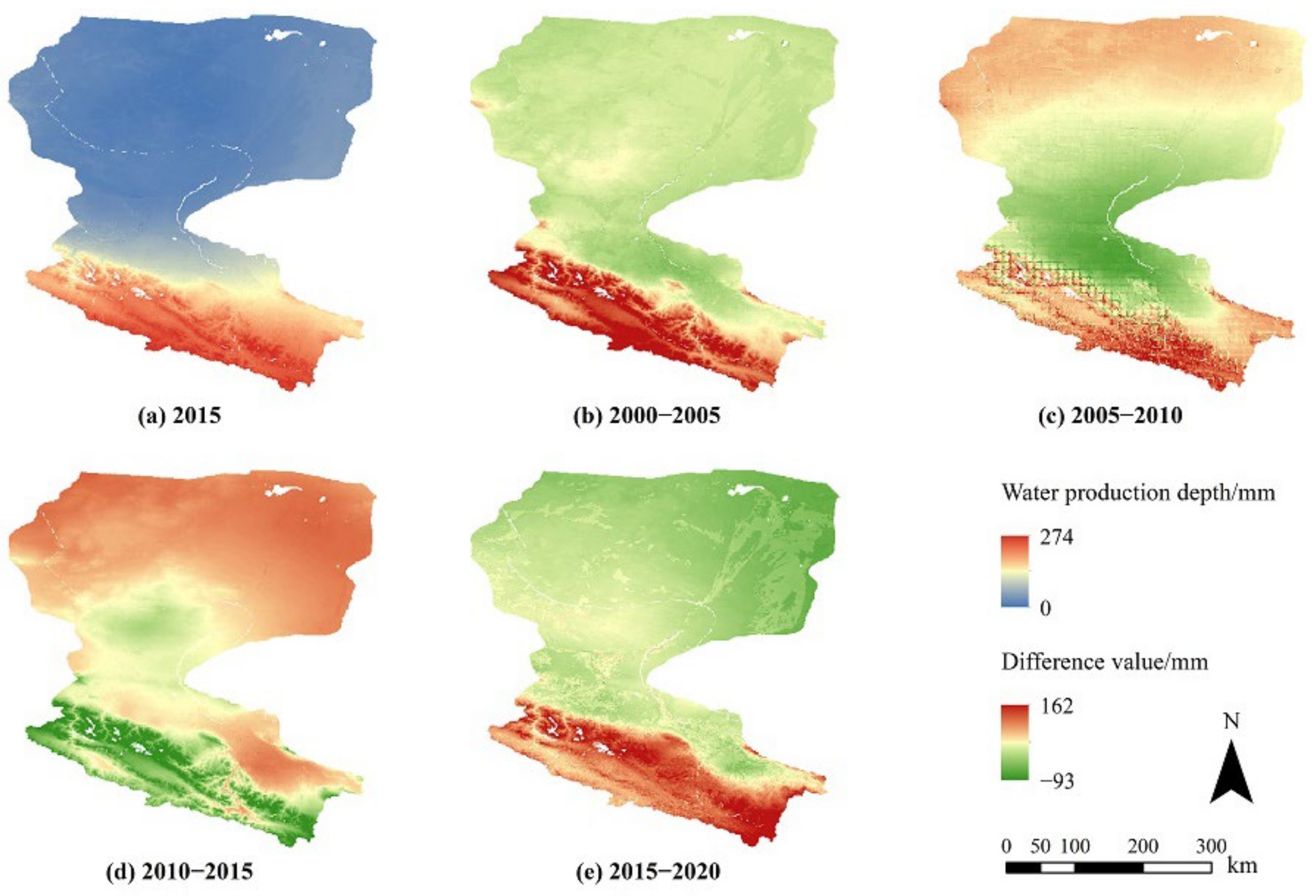

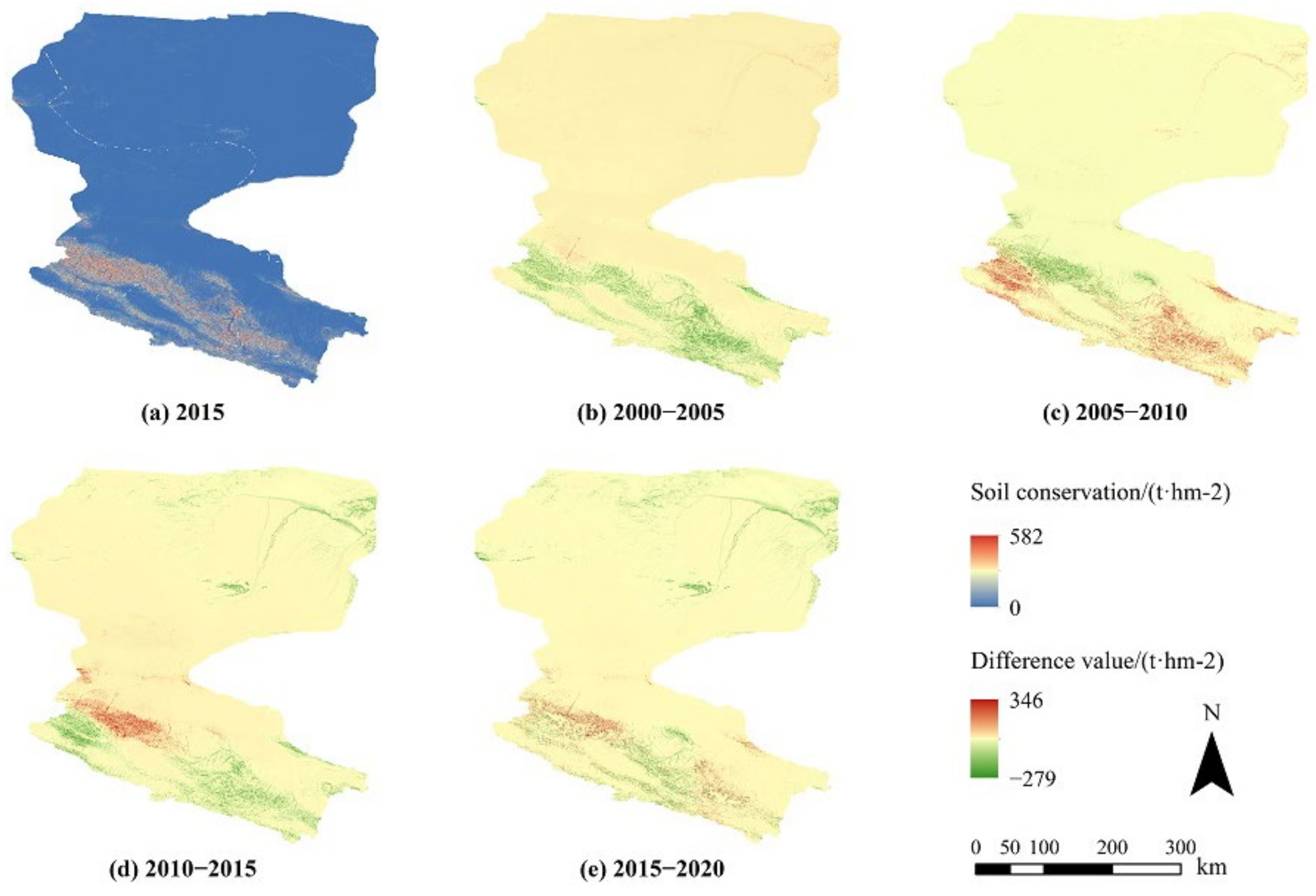



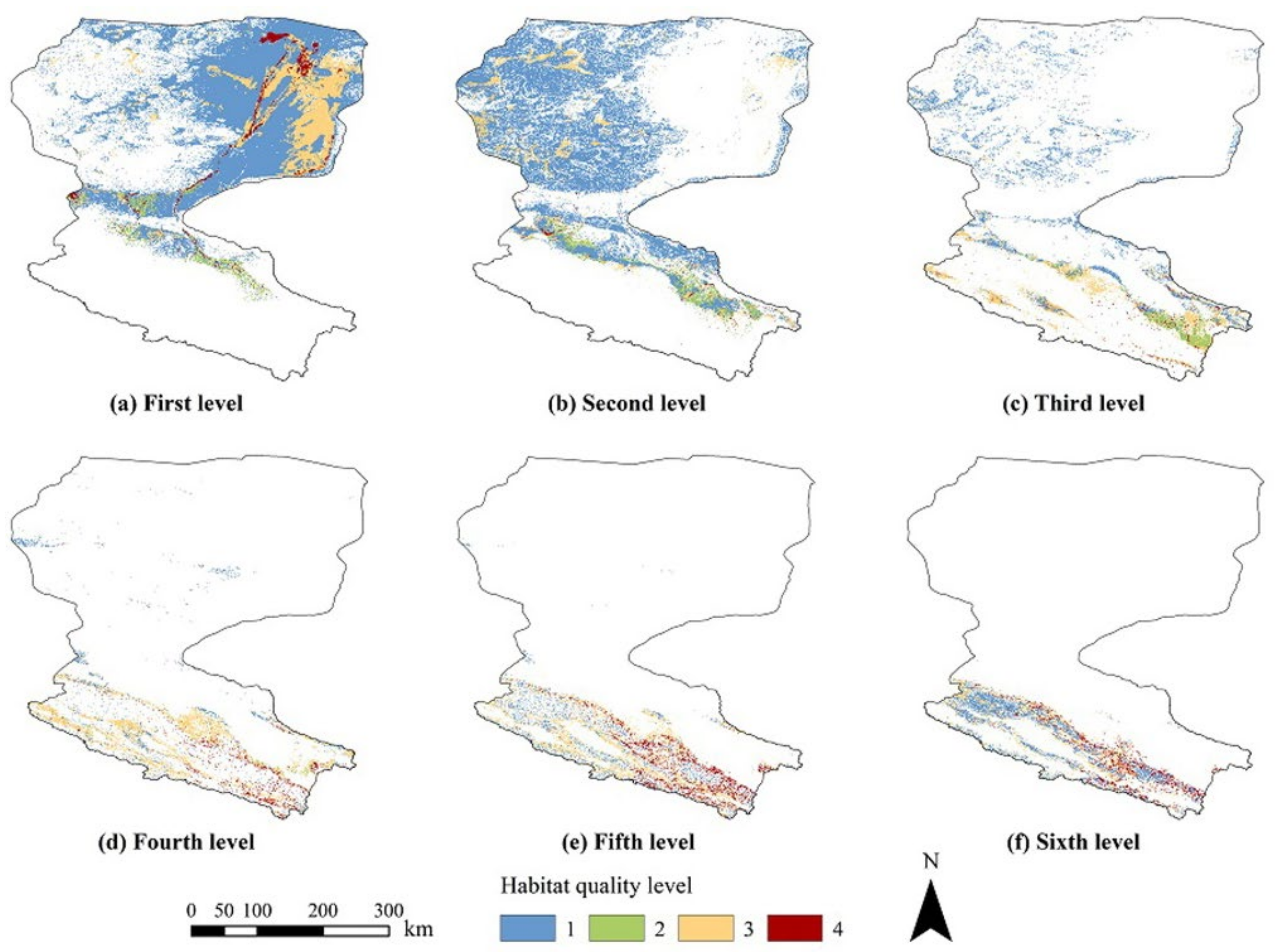

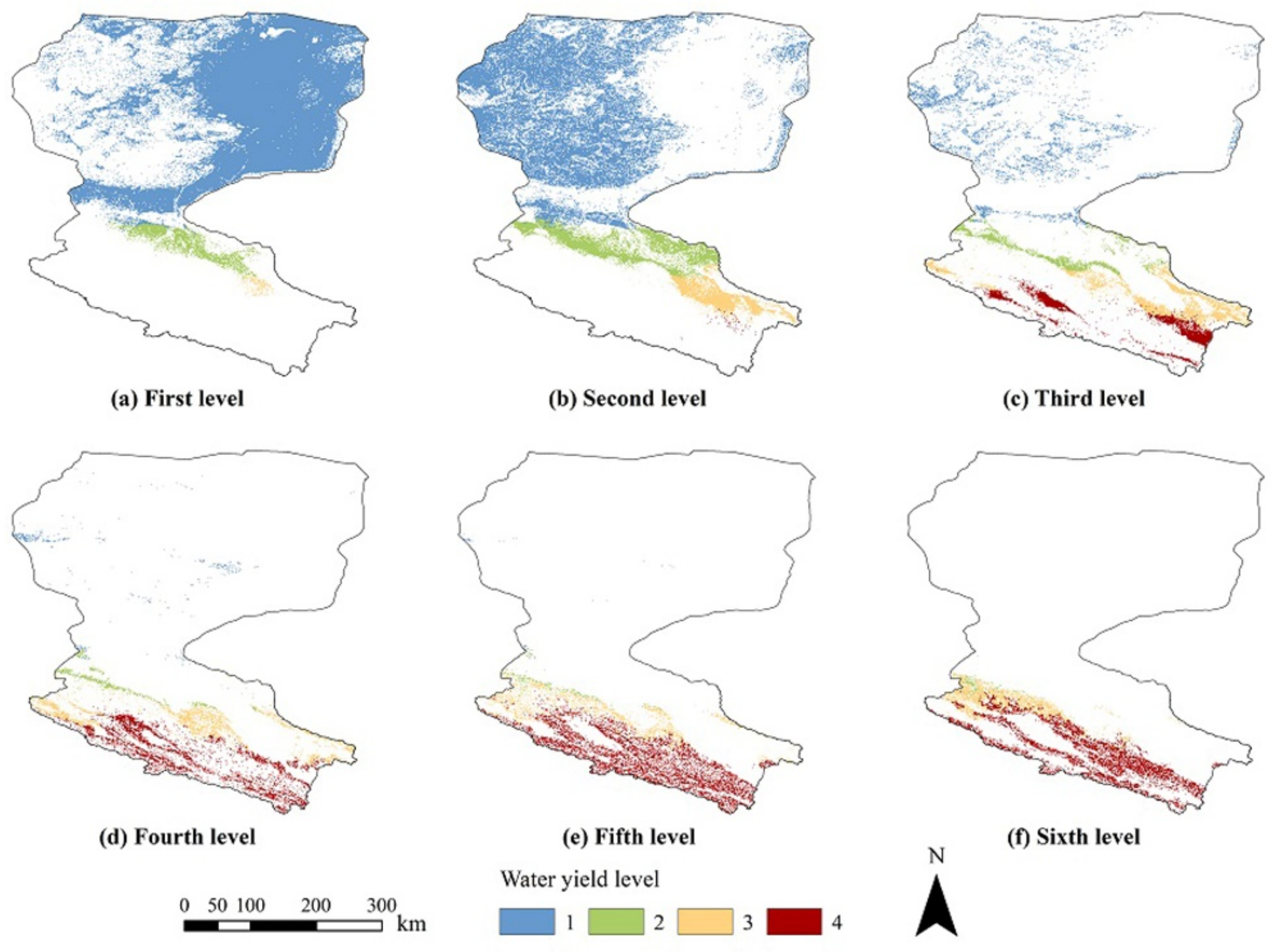
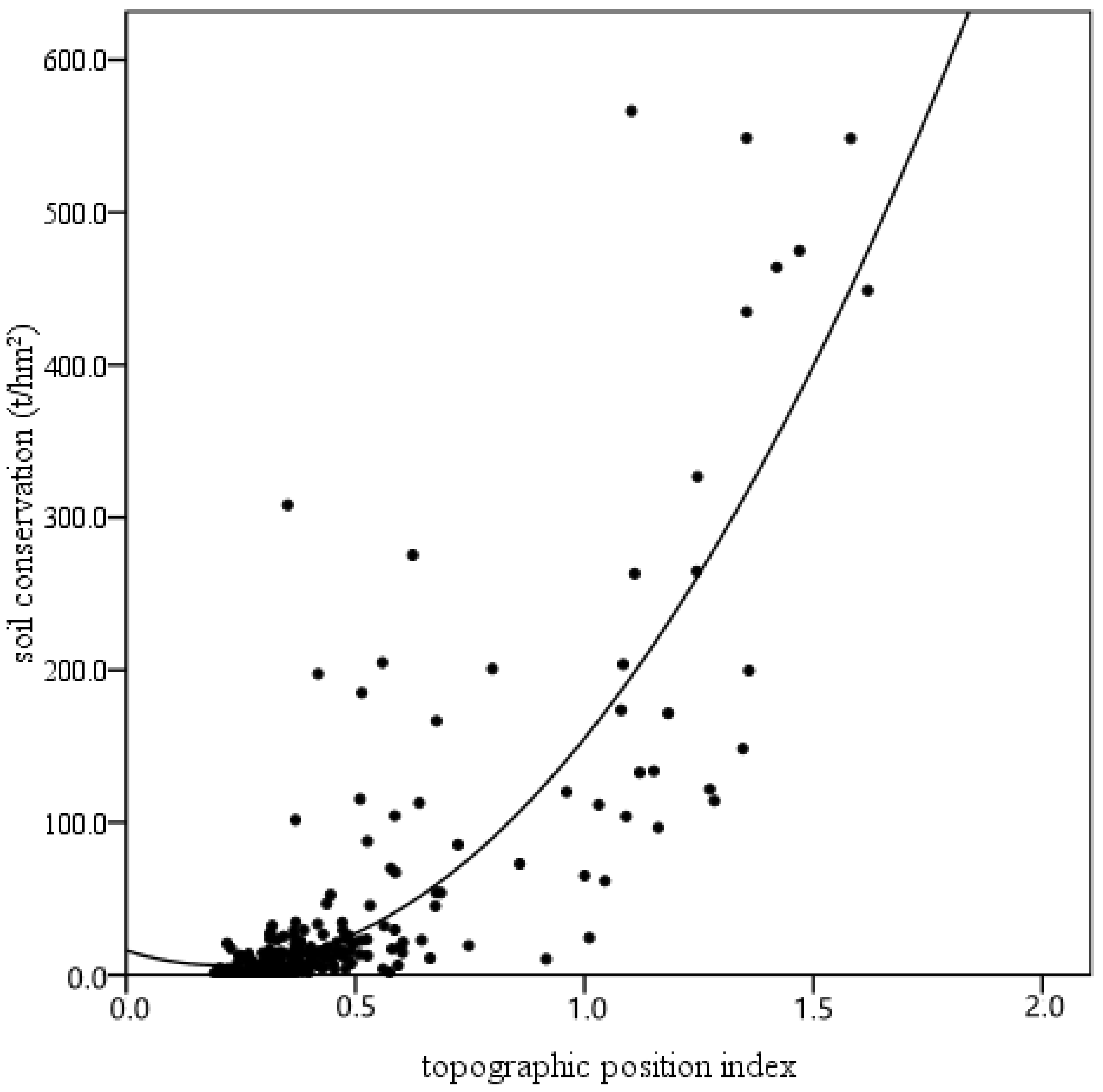

| Threat | Max-Dist/km | Weight |
|---|---|---|
| Cropland | 1 | 0.2 |
| Town | 8 | 0.9 |
| Residential area | 3 | 0.8 |
| Road | 10 | 0.6 |
| Habitat Type | Habitat Suitability | Cropland | Town | Residential Area | Road |
|---|---|---|---|---|---|
| Cropland | 0.4 | 0.5 | 0.4 | 0.5 | 0.45 |
| Forest | 0.8 | 0.4 | 0.8 | 0.6 | 0.5 |
| Grassland | 0.6 | 0.4 | 0.5 | 0.6 | 0.6 |
| Waters | 0.9 | 0.5 | 0.6 | 0.6 | 0.55 |
| Built-up land | 0 | 0 | 0 | 0 | 0 |
| Unused land | 0 | 0 | 0 | 0 | 0 |
| Terrain Niche Index Level | HQ Level | |||||||
|---|---|---|---|---|---|---|---|---|
| 1 | 2 | 3 | 4 | |||||
| 1 | 75.05 | −0.99 | 2.58 | 0.64 | 19.20 | 0.26 | 3.17 | 0.05 |
| 2 | 84.33 | −0.36 | 4.37 | 0.59 | 10.64 | −0.32 | 0.65 | 0.03 |
| 3 | 58.65 | −0.11 | 9.34 | 0.35 | 28.95 | 0.03 | 3.07 | −0.16 |
| 4 | 22.93 | 0.20 | 2.18 | 0.13 | 62.90 | −1.13 | 11.99 | 0.33 |
| 5 | 27.61 | 0.34 | 0.35 | 0.02 | 49.02 | 0.15 | 23.02 | −0.56 |
| 6 | 49.51 | −0.82 | 0.04 | 0.01 | 32.77 | 0.60 | 17.68 | 0.68 |
| Terrain Niche Index Level | WY Level | |||||||
|---|---|---|---|---|---|---|---|---|
| 1 | 2 | 3 | 4 | |||||
| 1 | 97.75 | −3.57 | 2.25 | 0.01 | 0.00 | 0.50 | 0.00 | 0.00 |
| 2 | 84.29 | −4.23 | 14.52 | −0.04 | 1.19 | 5.38 | 0.00 | 0.13 |
| 3 | 42.26 | 1.58 | 25.08 | 0.19 | 25.95 | −1.23 | 6.71 | 10.40 |
| 4 | 4.69 | 1.43 | 16.72 | −0.03 | 43.63 | −7.87 | 34.96 | 13.42 |
| 5 | 0.21 | 0.61 | 4.98 | −0.03 | 35.41 | −8.89 | 59.41 | 8.84 |
| 6 | 0.01 | 0.01 | 1.61 | 0.00 | 28.41 | 3.60 | 69.97 | −4.43 |
| Terrain Niche Index Level | SC Level | |||||||
|---|---|---|---|---|---|---|---|---|
| 1 | 2 | 3 | 4 | |||||
| 1 | 99.83 | −2.70 | 0.14 | 0.07 | 0.03 | 0.10 | 0.01 | 2.53 |
| 2 | 99.75 | −1.73 | 0.20 | 0.96 | 0.04 | 0.02 | 0.01 | 0.75 |
| 3 | 98.45 | 0.39 | 1.38 | −0.58 | 0.12 | −0.04 | 0.05 | 0.23 |
| 4 | 92.42 | −2.33 | 7.24 | −0.03 | 0.23 | 1.13 | 0.11 | 1.23 |
| 5 | 90.12 | 1.62 | 8.68 | −2.65 | 1.07 | 0.29 | 0.13 | 0.74 |
| 6 | 81.21 | −4.91 | 12.70 | 3.24 | 0.83 | −0.37 | 0.18 | 2.04 |
| ESs Supply | Results in This Paper | |||
|---|---|---|---|---|
| Year | Area | Range | Spatial Distribution | |
| HQ | 2015 | Midstream (by provincial boundaries) | 0.0–1.0 | General and higher in the central region while poor in the northern and southern regions |
| WY | 2000 | Midstream (by provincial boundaries) | 0.0–314.7 mm | More southeast, less northwest; obvious difference between the north–south and continuous distribution of high-value areas |
| SC | 2010 | HRB | 0–644 t/hm2 | More west and less east, more south and less north; high-value concentrated area in the southern part of middle reaches |
| ESs Supply | Results in Referenced work | |||
| Year | Area | Range | Spatial Distribution | |
| HQ | 2015 | Midstream (by Yingluo gorge and Zhengyi gorge) | 0.0–1.0 | General and higher-grade in the central and southern regions while poor in the northern regions |
| WY | 2000 | Midstream (by Yingluo gorge and Zhengyi gorge) | 0.0–306.0 mm | More southeast, less northwest; Dispersed distribution of high value areas |
| SC | 2011 | HRB | 0–646 t/hm2 | More west and less east; Sparse distribution of high-value areas along the riverside in the north and south basin |
| Land-Use Type | 2000 | 2005 | ||||
|---|---|---|---|---|---|---|
| Upstream | Midstream | Downstream | Upstream | Midstream | Downstream | |
| Cropland | 11.66 | 4617.33 | 60.41 | 11.66 | 4939.70 | 69.22 |
| Forest | 1487.75 | 2950.35 | 878.84 | 1487.75 | 2941.53 | 870.45 |
| Grassland | 5457.08 | 13,654.56 | 11,069.79 | 5457.08 | 13,598.84 | 11,053.02 |
| Waters | 228.56 | 805.92 | 332.60 | 228.56 | 803.08 | 356.77 |
| Built-up land | 10.24 | 414.33 | 135.16 | 10.24 | 449.15 | 135.19 |
| Unused land | 2756.17 | 33684.40 | 54,012.44 | 2757.61 | 33,394.58 | 54,003.63 |
| Land-Use Type | 2010 | 2015 | ||||
| Upstream | Midstream | Downstream | Upstream | Midstream | Downstream | |
| Cropland | 10.24 | 4959.17 | 66.95 | 10.24 | 5255.53 | 65.53 |
| Forest | 1513.77 | 2933.15 | 845.86 | 1511.92 | 2932.72 | 823.55 |
| Grassland | 5459.92 | 13,631.82 | 11,046.05 | 5459.92 | 13,535.16 | 11,170.57 |
| Waters | 217.90 | 799.38 | 388.32 | 216.48 | 870.45 | 377.66 |
| Built-up land | 10.24 | 452.43 | 135.12 | 10.24 | 572.25 | 133.33 |
| Unused land | 2755.76 | 33,327.20 | 54,016.13 | 2758.23 | 32,937.04 | 53,806.20 |
| Land-Use Type | 2020 | |||||
| Upstream | Midstream | Downstream | ||||
| Cropland | 16.45 | 6217.98 | 76.42 | |||
| Forest | 1401.17 | 3292.52 | 876.20 | |||
| Grassland | 5732.36 | 14,570.27 | 11,568.41 | |||
| Waters | 188.73 | 921.64 | 386.24 | |||
| Built-up land | 12.24 | 641.19 | 116.89 | |||
| Unused land | 2616.08 | 30,459.55 | 53,352.68 | |||
Publisher’s Note: MDPI stays neutral with regard to jurisdictional claims in published maps and institutional affiliations. |
© 2021 by the authors. Licensee MDPI, Basel, Switzerland. This article is an open access article distributed under the terms and conditions of the Creative Commons Attribution (CC BY) license (https://creativecommons.org/licenses/by/4.0/).
Share and Cite
Zhang, L.; Hu, N. Spatial Variation and Terrain Gradient Effect of Ecosystem Services in Heihe River Basin over the Past 20 Years. Sustainability 2021, 13, 11271. https://doi.org/10.3390/su132011271
Zhang L, Hu N. Spatial Variation and Terrain Gradient Effect of Ecosystem Services in Heihe River Basin over the Past 20 Years. Sustainability. 2021; 13(20):11271. https://doi.org/10.3390/su132011271
Chicago/Turabian StyleZhang, Lingge, and Ningke Hu. 2021. "Spatial Variation and Terrain Gradient Effect of Ecosystem Services in Heihe River Basin over the Past 20 Years" Sustainability 13, no. 20: 11271. https://doi.org/10.3390/su132011271





